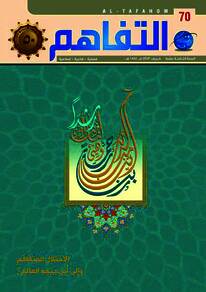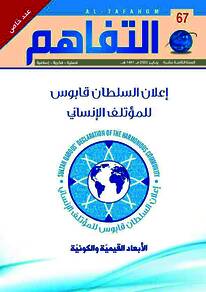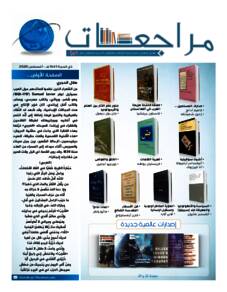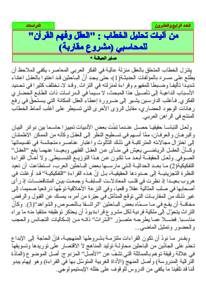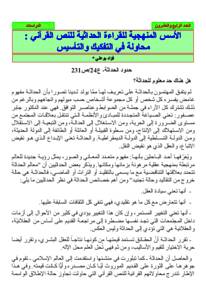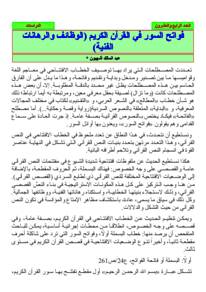Document
دلالات التناسب والتركيب في سورة يونس
Publisher
جامعة نزوى
Gregorian
2016
Language
Arabic
English abstract
The Holy Quran is based on a unique structure where no eloquence would be better than, nor expression would reach its magnificence. Each utterance is put in well-chosen place as the Quran system continues to bewilder the brightest minds: it is the miraculous speech of the Almighty Allah indeed.
Closely examining the Holy Quran Surahs (Chapters), a person would find out that they form a one unit theme; examining certain objectives and realizing majestic intentions. The Almighty Allah wants to manifest these in the verses of the Holy book that being revealed to the blessed heart of Prophet Mohammad.
However, the relevance of the Surahs is not only dependent on the thematic appropriateness, but it goes further to the structural one as it demonstrates accuracy of the Quran lexical choice, its consistence within structure as well as the impressive selection of its morphology and phonetics, and the perfect internal order of the verses in each Surah. This would be clearly shown on the suitability of the introduction and conclusion, arrangement of the verses' syllabus, linkage of each verse's interval with its introduction; thus, maintaining the Surah cohesion and its association with the precedent and subsequent ones. Taking these into consideration, the Holy Quran is taken as a one Surah because of its interconnection, and rather Al-Fakhr Al-Razi described it as one Surah, and the narratives are consistent with their purposes indeed.
'Relevance Science' provides researchers with exposure to the thematic blend, association in structure and order of Surah. Thus, I consider to write on this field, after this topic being deliberated with Dr. Hashim Al-Samurai, who advised me to select whether Surah of 'Yunus' or 'Al-Qasas' as they have not been studied yet in terms of 'Relevance Science'.
Reasons for topic selection:
The researcher opts for Surah 'Yunus; due to its external appropriateness with both 'Tauba' and 'Hud' Surahs, besides its internal appropriateness in terms of verses and syllabus. There are also a number of narratives connected in certain objectives, and bearing in mind that this Surah has not examined yet, despite the fact of its richness for study and application.
Significance of the study:
The importance of this research is derived from the fact that it is dedicated for the sake of serving the Holy Quran in the manifestation of its magnificent systems and revelation of some of its miracles. It would also entail scholars to diverse interpretations of the Quran verses.
Methodology:
1. Chapter one is titled 'Relevance of Text' and it reviews the text in 'Yunus' in two sections: (occasions in Yunus) and (suitability of narratives).
2. Chapter two divides the topic 'Relevance of Pattern and Lexical Similarity' into two sections: (Relevance of Pattern) and (Relevance of Lexical Similarity).
3. Chapter three examines 'Relevance of Systems' in two sections: (Relevance of Grammar Structure and Terminology) and (Relevance of Phonetics and Morphology).
4. The conclusion highlights the research findings in different chapters.
It is note-worthy that, researcher favored not to write an introduction about Relevance Science; given the prior extensive research on this field .
Arabic abstract
إن القرآن الكريم بناء فنيُّ فريد، لا يعلو عليه أي بيان، ولا يسمو عليه أي تعبير، فكل لفظة فيه عاشقة مكانها، لما يتميز به من نظمٍ أعجز الألباب، وتناسب عجيب حيَّر الأذهان، كيف لا، وهو كلام الملك الدَّيّان.
والذي ينعم النظر ويدقق البصر في سور القرآن الكريم يجد أنها تشكل لحمة موضوعية واحدة، متناولة مقاصد معينة، وأهدافًا سامية، ومرامي سامقة، أراد الله أن يبلورها في آي كتابه، ويؤكدَها في صفحات قرآنه الذي أنزله على قلب نبيه المصطفى .
ولا يقف التناسب في السور القرآنية عند حدِّ التناسب الموضوعي، بل يتعداه إلى التناسب في التركيب الذي يدلّ على الدقة في اختيار المفردة القرآنية، وانسجامها داخل التركيب، وروعة انتقاء بنيتها الصرفية، وأصواتها اللغوية، إلى جانب الوقوف على أوجه الإحكام في ترتيب آيات السورة القرآنية داخليًا، ويظهر ذلك في تناسب فاتحتها بخاتمتها، وتناسق مقاطع آياتها مع بعضها، وترابط فاصلة كل آية بصدرها، ممّا يجعل السورة نصًّا متماسكَ الأجزاء، لتترابط مرة أخرى مع السورة التي قبلها، والسورة التي بعدها، ومن ثَمَّ كان القرآن الكريم كلُّه كالسورة الواحدة لاتِّصال بعضه ببعض، بل هو كالآية الواحدة كما يقول الفخر الرازي، ناهيك عن تناسب القصص داخل كلّ سورة بما يتوافق مع مقاصد تلك السورة.
ويأتي علم المناسبة ليفتِّق للدارسين والباحثين عن هذا التلاحم الموضوعي والترابط في التركيب والترتيب في السور القرآنية، ولهذا قررت الكتابة في هذا العلم، بعد أن أوضح لي الأستاذ الدكتور أحمد هاشم السامرائي بعضًا من جوانب هذا العلم، وخَيَّرَني بين سورتي يونس والقصص لكونهما لم تُدْرسا بعدُ في ضوء علم المناسبة، فاخترت سورة يونس، فكان عنوان رسالتي : ( سورة يونس ـ دراسة لغوية في ضوء علم المناسبة ).
أسباب اختيار الموضوع :
1. أهمية علم المناسبة في خدمة كتاب الله الذي لا تنقضي عجائبه .
2. الرغبة في دراسة علم المناسبة في سورة يونس ؛ لكونها لم تُدرس بعد .
3. الوقوف على أسرار المناسبة بين آيات السورة ومقاطعها وقصصها وأساليبها.
4. التَّـدرُب على تحليل النصوص القرآنية في ضوء علم المناسبة .
أهمية الموضوع :
تتمثل أهمية الموضوع في أنه يخدم كتاب الله في تجليته روائع النظم فيه، وإظهار صورة من صور الإعجاز القرآنيّ، فضلًا عن كونه يفتح آفاقًا تفسيرية رحبة للمتدبرين في آياته .
خطة الرسالة :
اقتضت طبيعة البحث أن تقسم الرسالة إلى تمهيد وثلاثة فصول، مُذيلة بخاتمة وقائمة المصادر والمراجع، على وفق المنهجية الآتية :
1. التمهيد : وخصَّصته لـ ( علم المناسبة ) ، فتناولت فيه : ( تعريف علم المناسبة ، وبيان أهميته ، ومكانته في التراث ) .
2. الفصل الأول : عنوانه : ( تناسب النَّصّ )، فتناولت فيه نصّ سورة يونس على مبحثين : ( المناسبات في سورة يونس )، و( تناسب القصص ) .
3. الفصل الثاني : عنوانه : ( تناسب الأسلوب والمتشابه اللفظي )، فجاء على مبحثين : ( تناسب الأسلوب )، و( تناسب المتشابه اللفظي ) .
4. الفصل الثالث : ( تناسب النظم )، فجاء مقسمًا على مبحثين : ( تناسب التركيب النحوي والمفردة اللغوية )، و( تناسب التشكيل الصوتي و البنية الصرفية ) .
5. الخاتمة : اشتملت على أهم النتائج التي توصلت إليها هذه الرسالة في فصولها المختلفة.
والذي ينعم النظر ويدقق البصر في سور القرآن الكريم يجد أنها تشكل لحمة موضوعية واحدة، متناولة مقاصد معينة، وأهدافًا سامية، ومرامي سامقة، أراد الله أن يبلورها في آي كتابه، ويؤكدَها في صفحات قرآنه الذي أنزله على قلب نبيه المصطفى .
ولا يقف التناسب في السور القرآنية عند حدِّ التناسب الموضوعي، بل يتعداه إلى التناسب في التركيب الذي يدلّ على الدقة في اختيار المفردة القرآنية، وانسجامها داخل التركيب، وروعة انتقاء بنيتها الصرفية، وأصواتها اللغوية، إلى جانب الوقوف على أوجه الإحكام في ترتيب آيات السورة القرآنية داخليًا، ويظهر ذلك في تناسب فاتحتها بخاتمتها، وتناسق مقاطع آياتها مع بعضها، وترابط فاصلة كل آية بصدرها، ممّا يجعل السورة نصًّا متماسكَ الأجزاء، لتترابط مرة أخرى مع السورة التي قبلها، والسورة التي بعدها، ومن ثَمَّ كان القرآن الكريم كلُّه كالسورة الواحدة لاتِّصال بعضه ببعض، بل هو كالآية الواحدة كما يقول الفخر الرازي، ناهيك عن تناسب القصص داخل كلّ سورة بما يتوافق مع مقاصد تلك السورة.
ويأتي علم المناسبة ليفتِّق للدارسين والباحثين عن هذا التلاحم الموضوعي والترابط في التركيب والترتيب في السور القرآنية، ولهذا قررت الكتابة في هذا العلم، بعد أن أوضح لي الأستاذ الدكتور أحمد هاشم السامرائي بعضًا من جوانب هذا العلم، وخَيَّرَني بين سورتي يونس والقصص لكونهما لم تُدْرسا بعدُ في ضوء علم المناسبة، فاخترت سورة يونس، فكان عنوان رسالتي : ( سورة يونس ـ دراسة لغوية في ضوء علم المناسبة ).
أسباب اختيار الموضوع :
1. أهمية علم المناسبة في خدمة كتاب الله الذي لا تنقضي عجائبه .
2. الرغبة في دراسة علم المناسبة في سورة يونس ؛ لكونها لم تُدرس بعد .
3. الوقوف على أسرار المناسبة بين آيات السورة ومقاطعها وقصصها وأساليبها.
4. التَّـدرُب على تحليل النصوص القرآنية في ضوء علم المناسبة .
أهمية الموضوع :
تتمثل أهمية الموضوع في أنه يخدم كتاب الله في تجليته روائع النظم فيه، وإظهار صورة من صور الإعجاز القرآنيّ، فضلًا عن كونه يفتح آفاقًا تفسيرية رحبة للمتدبرين في آياته .
خطة الرسالة :
اقتضت طبيعة البحث أن تقسم الرسالة إلى تمهيد وثلاثة فصول، مُذيلة بخاتمة وقائمة المصادر والمراجع، على وفق المنهجية الآتية :
1. التمهيد : وخصَّصته لـ ( علم المناسبة ) ، فتناولت فيه : ( تعريف علم المناسبة ، وبيان أهميته ، ومكانته في التراث ) .
2. الفصل الأول : عنوانه : ( تناسب النَّصّ )، فتناولت فيه نصّ سورة يونس على مبحثين : ( المناسبات في سورة يونس )، و( تناسب القصص ) .
3. الفصل الثاني : عنوانه : ( تناسب الأسلوب والمتشابه اللفظي )، فجاء على مبحثين : ( تناسب الأسلوب )، و( تناسب المتشابه اللفظي ) .
4. الفصل الثالث : ( تناسب النظم )، فجاء مقسمًا على مبحثين : ( تناسب التركيب النحوي والمفردة اللغوية )، و( تناسب التشكيل الصوتي و البنية الصرفية ) .
5. الخاتمة : اشتملت على أهم النتائج التي توصلت إليها هذه الرسالة في فصولها المختلفة.
Member of
Resource URL
Same Subject
